 W
WTai chi, short for T'ai chi ch'üan or Tàijí quán (太極拳), sometimes colloquially known as "Shadowboxing", is an internal Chinese martial art practiced for defense training, health benefits, and meditation. The term taiji is a Chinese cosmological concept for the flux of yin and yang, and 'quan' means fist. Etymologically, Taijiquan is a fist system based on the dynamic relationship between polarities. Developed as a martial art, it is practiced for other reasons: competitive wrestling in the format of pushing hands, demonstration competitions, and greater longevity. As a result, a multitude of traditional and modern training forms exist corresponding to those aims with differing emphasis. Some training forms of tai chi are practiced with extremely slow movements.
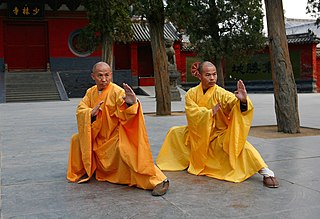 W
W103-form Yang family t'ai chi ch'uan, also called the Traditional Form, is a prescribed sequence of moves used to practice Yang-style t'ai chi ch'uan.
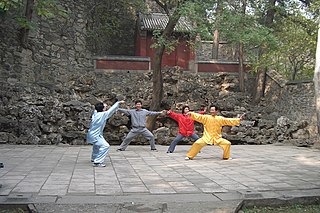 W
WThe Chen family-style or Chen-style Taijiquan is the oldest and parent form of the five traditional family styles of Taiji. Chen-style is characterized by silk reeling, alternating fast and slow motions and bursts of power.
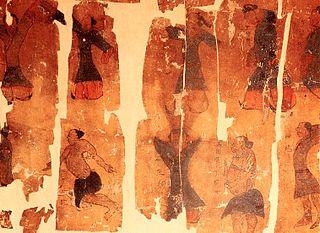 W
WDaoyin, also called Daoist neigong, is a series of body and mind unity exercises practiced by Daoists to cultivate jing (essence) and direct and refine qi, the internal energy of the body according to Traditional Chinese medicine. The practice of daoyin was a precursor of qigong, and was practised in Chinese Taoist monasteries for health and spiritual cultivation. Daoyin is also said to be a primary formative ingredient in the well-known "soft styles" of the Chinese martial arts, of Taiji quan. and middle road styles like Wuxingheqidao.
 W
WGuang Ping Yang Tai Chi Chuan, which has become known as the "lost" Yang-style tai chi chuan form, combines all the positive aspects of Yang Style with qualities that added strength and versatility. Guang Ping's stances are lower and wider than Yang style but not as pronounced as Chen style and are also distinguished by as little as a 51%/49% weight difference between leading and trailing foot in certain moves. A stronger, more balanced foundation gives the student more power and greater flexibility. Guang Ping Yang Tai Chi Chuan also combines Xingyiquan and Baguazhang energies, which can be seen in Guang Ping's spiral force energy and projecting force energy theories.
 W
WThe jian is a double-edged straight sword used during the last 2,500 years in China. The first Chinese sources that mention the jian date to the 7th century BCE, during the Spring and Autumn period; one of the earliest specimens being the Sword of Goujian. Historical one-handed versions have blades varying from 45 to 80 centimeters in length. The weight of an average sword of 70-centimetre (28-inch) blade-length would be in a range of approximately 700 to 900 grams. There are also larger two-handed versions used for training by many styles of Chinese martial arts.
 W
WList of T'ai chi ch'uan forms, postures, movements, or positions in order of number of forms:
 W
WPushing hands, Push hands or tuishou is a name for two-person training routines practiced in internal Chinese martial arts such as Baguazhang, Xingyiquan, Taijiquan, and Yiquan. It is also played as an international sport akin to Judo, Sumo and wrestling, such as in Taiwan, where the biannual Tai Chi World Cup is held.
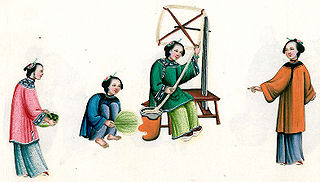 W
WSilk reeling refers to a set of neigong movement principles expressed in traditional styles of t'ai chi ch'uan (太極拳), but especially emphasised by the Chen 陳 and Wu 吳家 styles. The name derives from the twisting and spiralling movements of the silkworm larva as it wraps itself in its cocoon, and to the metaphorical principle of "reeling the silk from a silk worm's cocoon". Dozens of cocoons are placed into boiling water. A single strand coms from each cocoon. In order to draw out the silk successfully the action must be smooth and consistent without jerking or changing direction sharply. Too fast, the silk breaks, too slow, it sticks to itself and becomes tangled. The pot is then stirred and each cocoon spins as the silk unwinds. Each filament twists through a single point bo become thread. The thread is usually pulled over a wheel and wound onto a spool. Thus silk reeling movements are rotations within rotations that must be continuous, cyclic, focused, twisting and untwisting actions. Silk reeling is a core method of movement and is trained throughout the curriculum including solo forms, individual solo exercises, as well as in two-person work.
 W
WSingle Whip is a common posture found in most forms of t'ai chi ch'uan. Typically at the end of the posture the left hand is in a palm outward push and the right hand held most commonly in the form of a hook or closed fist. Notable exceptions are the Single Whip in Sun-style and Wu/Hao style t'ai chi ch'uan which finish with both hands open, palms outward.
 W
WThe Sun style (孙氏) t'ai chi ch'uan is well known for its smooth, flowing movements which omit the more physically vigorous crouching, leaping and fa jin of some other styles. Its gentle postures and high stances make it very suitable for martial arts therapy.
 W
WIn many extant t'ai chi classic writings the dependence of t'ai chi ch'uan on Chinese philosophy is acknowledged. T'ai chi teachers have historically asserted that the principles of tai chi chuan practice can be applied to a student's lifestyle.
 W
WThe T'ai chi Classics, or Taijiquan Classics, is a collection of over 100 articles on the Chinese martial art of t'ai chi ch'uan written by the art's master practitioners over the centuries. They cover everything from the underlying Taiji philosophical principles, to methods of practice and application. Previously passed down in secret from generation to generation in whole or in parts through various lineages, they achieved classical status as they became public starting in the mid-1930s. Together they now serve as the single authoritative guide for the development and usage of Taijiquan skills. Written mostly in classical Chinese, they are used today mostly by the serious martial art practitioners of modern 6 Lineages that all trace their lineages to the ancient style taught by the Chen family and Yang family starting in the mid-19th century.
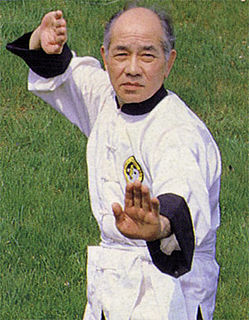 W
WThe Lee style of t'ai chi ch'uan (李氏太極拳) is closely related to a range of disciplines of Taoist Arts taught within the Lee style including Qigong, Tao Yin, Ch'ang Ming, Traditional Chinese Medicine, Taoist alchemy, Feng Shou Kung Fu, and weapons practice. According to practitioners, it was first brought to the West in the 1930s by Chan Kam Lee and was subsequently popularized by Chee Soo who was the President of the International Taoist Society from 1958 until his death in 1994. The Lee style of t'ai chi ch'uan comprises two forms known as 'the dance' or Tiào wǔ 跳舞, and 'the form'. Other exercises include I Fu Shou or 'sticky hands', Whirling Hands, Whirling Arms, and various qi and Li development exercises. Lee style t'ai chi is related to Martial Arts training, and there are five distinct areas of development that comprise the whole Art:Physical Mental Breathing Sheng Qi 生气 Ching Sheng Li 精生力.
 W
WTaoist Tai Chi is an exercise form of t'ai chi ch'uan which is taught in more than 25 countries by the non-profit International Taoist Tai Chi Society and associated national Taoist Tai Chi societies. It is a modified form of Yang-style t'ai chi ch'uan developed by Taoist monk Moy Lin-shin in Toronto, Ontario, Canada. Moy incorporated principles of Lok Hup Ba Fa and other internal arts to increase the health benefits of practising the form.
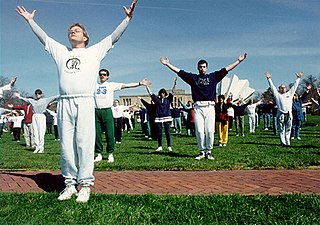 W
WWorld Tai Chi and Qigong Day (WTCQD), also spelled World T'ai Chi and Ch'i Kung Day, is an annual event held the last Saturday of April each year to promote the related disciplines of T'ai chi ch'uan and Qigong in nearly eighty countries since 1999.
 W
WThe Wu or Wu (Hao)-style of t'ai chi ch'uan of Wu Yuxiang (1813–1880), is a separate family style from the more popular Wu-style (吳氏) of Wu Chien-ch'üan. Wu Yuxiang's style was third among the five t'ai chi ch'uan families in seniority and is fifth in terms of popularity.
 W
WThe Wu family style t'ai chi ch'uan (Taijiquan) of Wu Quanyou and Wu Chien-ch'uan is the second most popular form of t'ai chi ch'uan in the world today, after the Yang style, and fourth in terms of family seniority. This style is different from the Wu style of t'ai chi ch'uan (武氏) founded by Wu Yu-hsiang. While the names are distinct in pronunciation and the Chinese characters used to write them are different, they are often romanized the same way.
 W
WYang family-style T‘ai-Chi Ch‘üan (Taijiquan) in its many variations is the most popular and widely practised style in the world today and the second in terms of seniority among the primary five family styles of T'ai Chi Ch'uan.
 W
WIn Ancient Chinese philosophy, yin and yang is a concept of dualism, describing how seemingly opposite or contrary forces may actually be complementary, interconnected, and interdependent in the natural world, and how they may give rise to each other as they interrelate to one another. In Chinese cosmology, the universe creates itself out of a primary chaos of material energy, organized into the cycles of Yin and Yang and formed into objects and lives. Yin is the receptive and Yang the active principle, seen in all forms of change and difference such as the annual cycle, the landscape, sexual coupling, the formation of both men and women as characters and sociopolitical history.
 W
WZhaobao taijiquan is a style of taijiquan that is often considered to be a modern style, but actually has a strong documented lineage that confirms its authenticity as an ancient style of taijiquan and as a true transmission from Wang Zongyue.